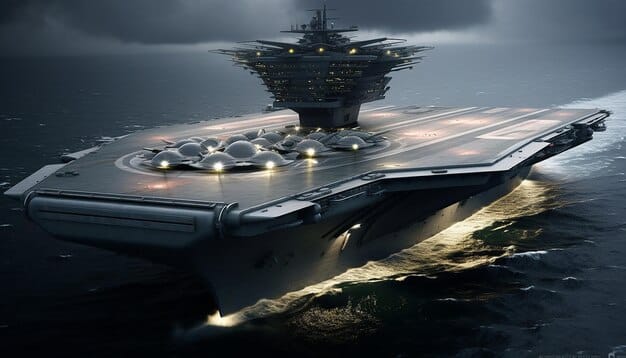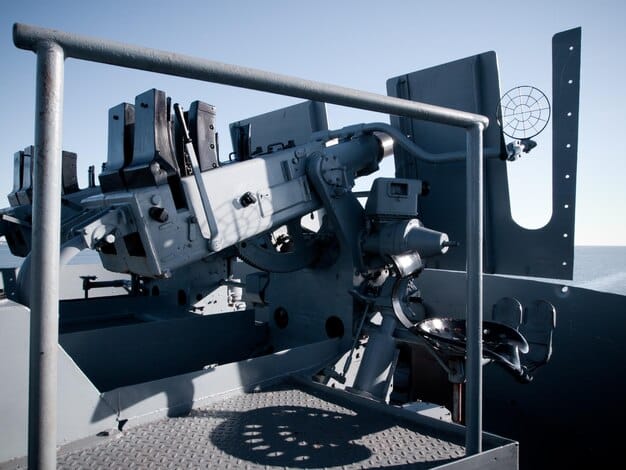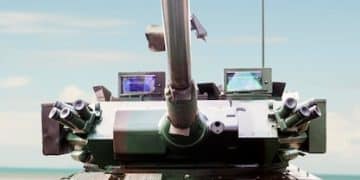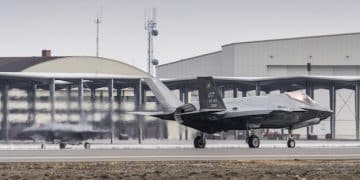US Navy’s Directed Energy Weapons by 2025: A Reality Check

The prospect of directed energy weapons on US Navy ships by 2025 is a complex issue, with significant research and development progress tempered by technological hurdles, budgetary constraints, and the strategic complexities of full-scale integration into operational fleets.
The notion of futuristic laser and microwave weapons defending naval vessels might seem like science fiction, yet the question, “Will Directed Energy Weapons Be Deployed on US Navy Ships by 2025?” is surprisingly pertinent. As global tensions rise and technological advancements accelerate, understanding the trajectory of these next-generation defense systems becomes crucial for anyone interested in military technology and national security.
the promise of directed energy weapons
Directed Energy Weapons (DEWs) represent a paradigm shift in military capabilities, offering potential advantages far beyond conventional projectile-based systems. These weapons, which include lasers, high-power microwaves, and particle beams, operate by emitting highly focused energy that can damage or disable targets at the speed of light. The allure of DEWs lies in their precision, their ability to engage multiple threats rapidly, and their potentially lower cost per shot compared to expensive interceptor missiles.
For the US Navy, the integration of DEWs could significantly enhance ship self-defense capabilities against emerging threats, particularly swarms of drones, fast attack craft, and sophisticated anti-ship missiles. Imagine a future where a single destroyer could fend off numerous threats without depleting its conventional missile magazines, thereby extending its operational endurance in high-threat environments.
initial concepts and early developments
Early concepts for directed energy weapons emerged decades ago, often confined to theoretical discussions and highly classified research laboratories. The scientific principles were understood, but the engineering challenges of miniaturization, power generation, thermal management, and beam propagation in real-world atmospheric conditions were formidable. Early prototypes were massive, inefficient, and impractical for shipboard integration.
However, sustained investment in defense research and development, coupled with breakthroughs in fiber optics, solid-state lasers, and power electronics, began to transform these theoretical concepts into tangible, albeit experimental, hardware. The journey from laboratory curiosity to potential naval deployment has been long and arduous, marked by continuous innovation and incremental successes.
- Reduced cost per engagement: DEWs offer significant savings over traditional missile interceptors.
- Deep magazine capacity: The “magazine” is limited by power, not physical rounds.
- High precision and speed: Engages targets at the speed of light with pinpoint accuracy.
As the potential of directed energy became clearer, the US Navy intensified its efforts, moving from basic science experiments to integrated system demonstrations. This shift marked a critical turning point, indicating a serious intent to transition these revolutionary technologies from the drawing board to the fleet. The promise was immense, but the hurdles remained substantial.
The initial focus was often on defensive applications, particularly neutralizing small, fast-moving threats that are difficult to counter with conventional systems. The concept of a “shoot-down cost” that is nearly negligible for DEWs, compared to millions of dollars for a single interceptor missile, provided a compelling economic argument for their development.
Looking ahead, the evolution of DEWs isn’t merely about developing more powerful lasers or microwave emitters, but about integrating them seamlessly into a ship’s existing combat systems, power grid, and operational procedures. This holistic approach is critical for their eventual widespread adoption across the fleet, transforming naval defense as we know it.
current status of directed energy weapon deployment
The US Navy has made significant strides in testing and demonstrating directed energy weapon prototypes on its ships. While fully operational, fleet-wide deployment remains a future goal, several key systems have completed successful at-sea trials, providing invaluable data and proving the viability of the technology. These demonstrations are crucial steps in bridging the gap between research and practical application.
One of the most publicized efforts is the Laser Weapon System (LaWS), which was deployed on the USS Ponce in the Persian Gulf from 2014 to 2017. LaWS successfully engaged various targets, including unmanned aerial vehicles (UAVs) and small boats, demonstrating its effectiveness in a real-world maritime environment. This deployment, while experimental, provided invaluable operational insights.

operational prototypes and testing
Beyond LaWS, the Navy has continued its testing with more advanced systems. The Optical Dazzling Interdictor, Navy (ODIN) system is another example, designed to counter adversary intelligence, surveillance, and reconnaissance (ISR) capabilities. ODIN has been installed on some destroyers, indicating a measured step towards integrating defensive DEW capabilities into the fleet.
- LaWS: Demonstrated on USS Ponce, successfully engaging UAVs and small boats.
- ODIN: Deployed on destroyers for counter-ISR operations, focusing on dazzling and disruption.
- HELIOS: High Energy Laser with Integrated Optical Dazzler and Surveillance tested for integration with Aegis combat system.
The High Energy Laser with Integrated Optical Dazzler and Surveillance (HELIOS) system represents a more powerful and integrated approach. Lockheed Martin delivered the first HELIOS system to the Navy in 2022 for integration and testing on a destroyer. HELIOS aims to not only provide defensive capabilities but also to integrate directly with the ship’s Aegis combat system, enhancing targeting and threat engagement.
These prototypes illustrate the Navy’s phased approach: start with lower-power systems for dazzling or soft-kill capabilities, then scale up to higher-power systems capable of hard-kill engagements. Each successive system builds on the lessons learned from its predecessors, addressing challenges in power management, thermal control, and beam stability in dynamic maritime conditions.
The data collected from these at-sea trials is critical for refining designs, identifying further engineering challenges, and developing standard operational procedures. This iterative process of testing, evaluation, and refinement is fundamental to moving DEWs from experimental systems to reliable, deployable assets in the naval inventory.
While an impressive series of tests have occurred, it is important to distinguish between successful demonstrations and full combat readiness. The current prototypes are proving concepts and gathering data, but moving to mass production and widespread deployment requires overcoming additional hurdles related to scalability, resilience, and training.
technological hurdles and breakthroughs
Despite significant progress, the full-scale deployment of directed energy weapons on US Navy ships by 2025 faces several persistent technological hurdles. While breakthroughs have been made, translating laboratory success into robust, shipboard-ready systems for a global fleet presents unique engineering challenges. These obstacles are what often temper optimistic timelines.
One primary challenge is power generation and management. High-energy lasers require immense amounts of electrical power, far beyond what many existing naval vessels are designed to supply for continuous operation of such systems. Integrating DEWs necessitates substantial upgrades to shipboard power grids, including more efficient generators and advanced energy storage solutions.
power and thermal management
The issue of thermal management is closely linked to power. When a high-energy laser fires, it generates a significant amount of waste heat. Dissipating this heat effectively and efficiently, particularly in the confined spaces of a ship, is critical to prevent overheating and ensure system longevity. This requires advanced cooling systems that are both compact and reliable.
Beam propagation in a maritime environment also poses challenges. Atmospheric conditions like fog, rain, and heat haze can absorb or scatter laser light, reducing its effectiveness and range. While some atmospheric compensation techniques exist, ensuring consistent performance across varying conditions at sea remains an area of active research and development.
- Power Demands: Requires substantial shipboard electricity generation and storage.
- Thermal Control: Efficiently dissipating waste heat is crucial for sustained operation.
- Beam Propagation: Overcoming atmospheric effects like fog and heat haze at sea.
Miniaturization is another key hurdle. Early DEW prototypes were often large and unwieldy, unsuitable for installation on many naval vessels. Significant engineering efforts have focused on reducing the size and weight of these systems while maintaining or increasing their power output and efficiency. This design constraint often necessitates trade-offs in other areas.
Reliability and maintainability are also critical for operational deployment. Unlike a research prototype, a deployed DEW system must function reliably for extended periods in harsh maritime conditions, with minimal downtime for maintenance. This demands robust designs, fault-tolerant architectures, and accessible components for repair.
Despite these hurdles, continuous breakthroughs in solid-state laser technology, innovative cooling systems, and advanced power electronics are steadily bringing these systems closer to widespread viability. The iterative process of testing and refinement on demonstrator platforms is essential for overcoming these challenges and maturing the technology.
The pace of these breakthroughs will ultimately dictate the speed at which DEWs transition from experimental prototypes to fully integrated and battle-ready assets within the US Navy’s operational fleet, moving beyond the demonstration phase to mass deployment.
budgetary considerations and strategic priorities
The acquisition and integration of directed energy weapons into the US Navy’s fleet are not merely technological endeavors; they are profoundly influenced by complex budgetary considerations and evolving strategic priorities. Funding for such cutting-edge systems competes with numerous other defense needs, from shipbuilding to personnel costs and maintenance of existing fleets.
Developing and deploying DEWs requires significant upfront investment in research, development, testing, and evaluation (RDT&E) as well as procurement. While the “cost per shot” of a DEW might be low, the initial capital expenditure for the system itself, along with necessary ship modifications, can be substantial. This large initial outlay often leads to careful scrutiny and prioritization.
funding and defense allocation
The US Department of Defense operates under finite budgets, meaning choices must be made about where to allocate resources. Programs for directed energy weapons must demonstrate clear cost-effectiveness and operational advantages over existing or alternative systems to secure sustained funding. This competitive environment for budget allocation can directly impact deployment timelines.
Strategic priorities also play a crucial role. The need for DEWs is often framed in the context of countering specific evolving threats, such as sophisticated anti-ship missiles, hypersonic weapons, and drone swarms, particularly from peer or near-peer competitors. If these threats escalate or change, the urgency and funding for DEW deployment might increase or shift accordingly.
- Upfront Investment: Significant R&D and procurement costs.
- Competitive Funding: DEWs compete with other critical defense programs.
- Strategic Threat Perception: Rapid evolution of threats influences funding urgency.
The balance between immediate operational needs and long-term technological transformations is a constant challenge for defense planners. While DEWs promise revolutionary capabilities in the future, the Navy must still invest in conventional weapons and platforms necessary for current global operations. This dual requirement often leads to a phased approach to new technology adoption.
Furthermore, sustainment costs are a critical factor. Once deployed, DEW systems will require ongoing maintenance, training for operators and technicians, and potential upgrades. These lifecycle costs must be factored into budgetary planning, adding another layer of complexity to their widespread integration.
The political landscape and public perception also influence budgetary decisions. Large-scale defense projects are often subject to intense congressional oversight and public debate, which can impact funding levels and program stability. Demonstrating tangible progress and clear benefits is essential for maintaining support.
Ultimately, the timeline for widespread DEW deployment on US Navy ships is as much a function of these financial and strategic considerations as it is of purely technological advancements. The ability to secure consistent, robust funding and align DEW capabilities with top strategic priorities will be paramount for their accelerated integration into the fleet.
integration challenges and operational readiness
Even with successful technological development and adequate funding, the integration of directed energy weapons into existing naval platforms presents a unique set of challenges that directly impact their operational readiness. A weapon system is only effective if it can be seamlessly incorporated into a ship’s structure, power systems, combat management system, and personnel training pipeline.
Physical integration is a major hurdle. Modern naval ships are intricately designed and packed with complex systems. Adding a significant new weapon, particularly one with specific power and cooling requirements, often necessitates substantial structural modifications, changes to utility routing, and careful consideration of weight and balance. This is particularly true for retrofit scenarios on older vessels.
combat system and personnel integration
Integrating DEWs into a ship’s combat management system (CMS) is equally complex. The CMS is the central nervous system of a warship, processing sensor data, tracking targets, and coordinating weapon engagements. A DEW must be able to seamlessly receive targeting data, respond to combat system commands, and provide feedback on its status and engagement outcomes. This requires extensive software development and rigorous testing.
Standardizing interfaces and protocols across different ship classes and weapon developers is also essential for a coherent fleet-wide deployment. Without common standards, each integration becomes a bespoke engineering project, increasing costs and complicating maintenance.
- Physical Integration: Structural modifications and utility routing on diverse ship classes.
- Combat System Integration: Seamless data flow and command execution with existing CMS.
- Personnel Training: Developing new skill sets for operators and maintenance crews.
Perhaps one of the most underestimated challenges is personnel readiness. Operating and maintaining DEWs requires specialized skills that differ significantly from conventional weapon systems. This means developing new training programs for sailors, from basic operators to advanced technicians. Ensuring a sufficient pool of qualified personnel capable of deploying, maintaining, and troubleshooting these complex systems is a long-term undertaking.
Logistics and supply chain management for DEW components are also new territories. Unlike traditional munitions, DEWs rely on highly specific and often proprietary hardware. Establishing robust supply chains for spare parts, calibration equipment, and specialized support services is vital for sustained operational readiness across a global fleet.
Furthermore, developing doctrines and tactics for DEW employment is an ongoing process. Sailors need to understand not only how the systems work but also when and how to best use them in different tactical scenarios, integrating them effectively with other shipboard defenses and offensive capabilities. This tactical evolution will be crucial for maximizing their impact.
The path to full operational readiness involves not just building the hardware but embedding it within the entire naval ecosystem – from design and construction to training, logistics, and tactical doctrine. These integration challenges often dictate the true pace of widespread deployment, extending timelines beyond initial technological demonstrations.
beyond 2025: the long-term vision for dews
While the question “Will Directed Energy Weapons Be Deployed on US Navy Ships by 2025?” suggests an immediate horizon, the US Navy’s vision for these systems extends far beyond this near-term milestone. 2025 is less an endpoint and more a critical checkpoint in a multi-decade journey towards a more interconnected and energetically armed fleet. The capabilities foreseen for the long-term are truly transformative.
Post-2025, the focus will likely shift from initial, often lower-power, defensive systems to higher-power, multi-mission capabilities. This includes not only more potent lasers capable of engaging larger and faster threats, but also the potential for offensive applications, such as disabling enemy sensors or communications at range, or even precision strike capabilities.
future capabilities and strategic implications
The concept of an “electric” or “all-electric” ship is closely tied to the long-term vision for DEWs. Future naval vessels are being designed with integrated power systems that can dynamically allocate energy to propulsion, ship services, and high-energy weapon systems, providing the necessary power for sustained DEW operations without compromising other functions.
The integration of advanced artificial intelligence and machine learning will also play a pivotal role. AI could enable DEW systems to rapidly identify, track, and prioritize multiple incoming threats, calculate optimal engagement parameters, and even learn from combat scenarios to improve performance over time, reducing operator workload and reaction times significantly.
- Escalating Power: Moving to higher-power lasers for diverse targets.
- Electric Ship Concepts: Integrated power systems for dynamic energy allocation.
- AI Integration: Enhanced targeting, threat prioritization, and autonomous operation.
Another key aspect of the long-term vision is the potential for DEWs to form part of a layered defense architecture. Rather than replacing conventional weapons, DEWs are envisioned as augmenting them, providing an additional tier of defense that can efficiently handle certain types of threats (e.g., swarms of drones) while preserving valuable missile magazines for high-priority targets.
Interoperability with allied naval forces will also become increasingly important. As DEW technology matures, there will be a push for standardization and shared doctrines to enable seamless cooperation in multinational operations, enhancing collective security against common adversaries. This vision requires significant diplomatic and technical collaboration.
The strategic implications are profound. A fleet widely equipped with advanced DEWs could reshape naval warfare, offering enhanced survivability, extended operational reach, and a cost-effective means of deterring or defeating a wider range of threats. The “cost curve” benefits of DEWs could fundamentally alter the economics of naval defense and offense.
Ultimately, beyond 2025, directed energy weapons are poised to become a staple of naval power for the US and its allies, evolving from experimental prototypes to indispensable components of future maritime security, fundamentally altering the calculus of naval engagements for decades to come.
| Key Point | Brief Description |
|---|---|
| ⚡️ Technological Progress | Significant strides in laser power, miniaturization, and thermal management. |
| 🚢 Operational Prototypes | LaWS, ODIN, and HELIOS have demonstrated at-sea capabilities. |
| 💰 Budget & Strategy | Deployment is influenced by funding competition and global threat priorities. |
| ⚙️ Integration Challenges | Physical, combat system, and personnel readiness are key hurdles. |
frequently asked questions about naval directed energy weapons
Experimental and prototype directed energy weapons like LaWS and ODIN have been successfully tested and deployed on a limited number of US Navy ships. While these systems demonstrate the viability and potential of DEWs, they are primarily for testing and gathering data, not yet full-scale operational deployment across the entire fleet.
The US Navy is primarily focused on developing high-energy lasers and high-power microwave weapons. Lasers are designed for precision engagements, such as neutralizing drones and small boats, or dazzling enemy sensors. Microwave weapons, on the other hand, can disrupt or disable electronic systems over a wider area.
The primary advantages include a significantly lower cost per shot compared to missiles, a “deep magazine” capacity (limited by power, not physical rounds), near-instantaneous engagement at the speed of light, and the ability to engage multiple targets rapidly. This makes them ideal for countering swarming threats and reducing reliance on expensive interceptors.
Key challenges include significant electrical power requirements, effective thermal management, maintaining beam quality in adverse weather conditions at sea, and integrating these complex systems seamlessly into existing ship designs and combat management systems. Budgetary constraints and personnel training are also major factors.
In the long term, DEWs are expected to become an integral part of a layered defense, enhancing ship survivability and operational endurance. They could also pave the way for “all-electric” ships and potentially enable new offensive capabilities. This shift will fundamentally alter the economics and tactics of naval engagements, impacting global maritime security.
conclusion
The question of whether Will Directed Energy Weapons Be Deployed on US Navy Ships by 2025? is not a simple yes or no. While significant strides have been made, with prototypes like LaWS, ODIN, and HELIOS demonstrating real-world capabilities, widespread, fleet-wide deployment as fully integrated and operational combat systems remains a complex undertaking. The journey from successful demonstration to widespread operational readiness involves overcoming substantial technological hurdles in power generation and thermal management, managing significant budgetary constraints and strategic priorities, and mastering the complex challenges of physical and combat system integration, along with extensive personnel training.
By 2025, we are likely to see continued, perhaps increased, deployment of experimental and limited-capability DEW systems on select vessels, serving as advanced testbeds for further development and refinement. However, the vision of a fleet where every major warship is routinely equipped with high-power, multi-mission directed energy weapons is a longer-term reality, extending well beyond the immediate 2025 horizon. It represents a continuous evolution, driven by innovation, strategic necessity, and the iterative process of turning ambitious concepts into enduring naval capabilities. The foundation is being laid, but the full architectural build will take more time, resources, and persistent effort.





